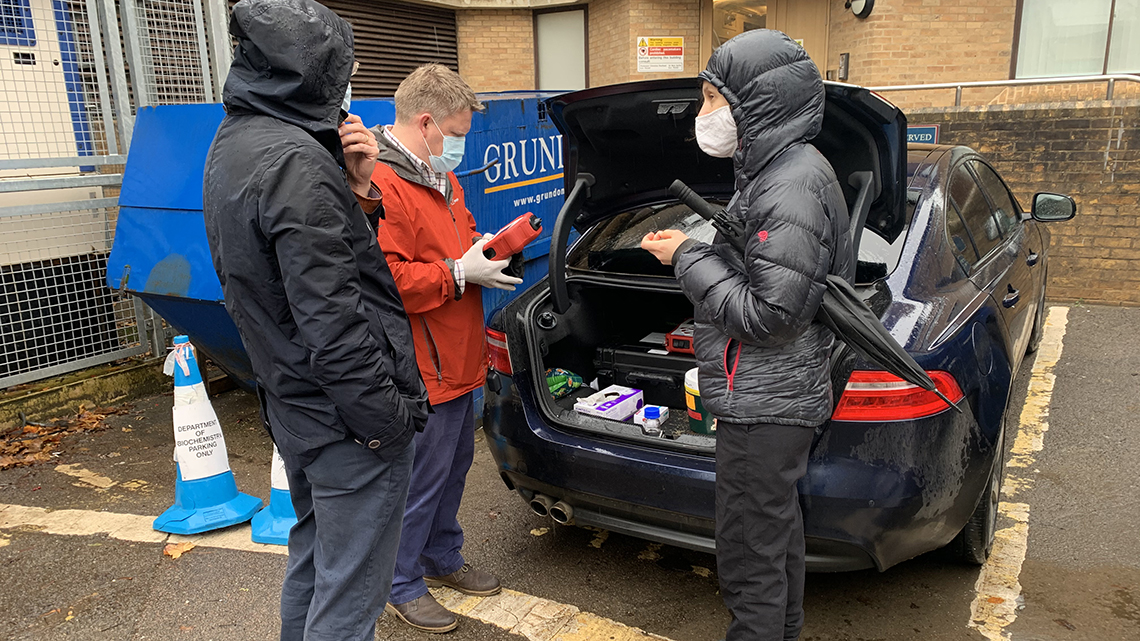Vaccine Identity Evaluation
Vaccine Identity Evaluation
Substandard (usually due to degradation) and falsified (aka counterfeit) vaccines are neglected public health problems with minimal research to innovate to allow their detection in supply chains. The multidisciplinary Vaccine Identity Evaluation (VIE) Collaboration began early in the pandemic to bring together diverse scientists with medicine regulatory authorities, international organisations and device and vaccine manufacturers to evaluate and develop novel techniques to protect the global vaccine supply. The results have been very promising and we are expanding to evaluate the different techniques in near-to-real life situations.

The COVID-19 pandemic has highlighted the neglected public health problem of substandard (usually due to incorrect temperature storage and rarely due to manufacturing errors) and falsified (aka counterfeit) (SF) vaccines in supply chains.
There have been multiple reports of SF vaccines, both pre-pandemic and for COVID-19, with 184 reports from 48 countries of diverted, substandard or falsified vaccines during the pandemic.
Increasing reports are a public health concern and risk global vaccination implementation, for endemic diseases and preparations for the next pandemic. They risk excess morbidity and mortality, economic losses and vaccine hesistancy.
The high demand for vaccines but impaired access, especially in some low-and middle income countries, is likely to be a key driver of vaccine falsification by criminals. Substandard vaccines arise from, thankfully, rare errors during manufacturing and errors in the cold chains.
There are currently no effective devices for inspectors to screen for SF vaccines in supply chains. Devices are needed both at distal levels of the supply chain and at national proximal sites, such as border points, for imported products. Therefore, there is a vital need for research into innovative, accurate, affordable, rapid and user-friendly screening devices that can be effectively implemented to yield a step change in our ability to rapidly detect SF vaccines, at different levels in diverse supply chains, to protect vaccine-related global healthcare.
The Vaccine Identity Evaluation (VIE) Collaboration has been pioneering solutions since early in the pandemic. It links up the Medicines Quality Research Group (PI - Prof Paul Newton, within the Nuffield Department of Medicine), the Department of Biochemistry (PI Prof. Nicole Zitzmann), the Department of Chemistry (PI Prof. James McCullagh), the Rutherford Appleton Laboratory (RAL, PI Prof Pavel Matousek) of UKRI and the University of Huddersfield (Prof Hamid Merchant), with the Oxford University Hospitals NHS Foundation Trust and vaccine and device manufacturer collaborators.
Visit our Team page for a list of current investigators
The VIE team are evaluating devices and developing protocols for screening SF vaccines in supply chains which includes repurposing of existing technologies as well as exploring the development of additional novel techniques.
The data, with three COVID-19 and five non-COVID vaccines, strongly suggests that Matrix-assisted laser desorption/ionization-time-of-flight mass spectrometry (MALDI-TOF), spatially-offset Raman spectroscopy (SORS), and rapid diagnostic tests (RDTs) are able to detect vaccine falsification and that MALDI-TOF and RDTs are able to detect chemical changes after inappropriate storage conditions. We are also investigating a diversity of lower cost techniques, that hold promise for screening in distal supply chains. The three technologies have been chosen, with pilot evidence of their diagnostic capabilities, to be directly applicable to proximal (MALDI-TOF, SORS), provincial (SORS) and distal (SORS, RDT) supply chain locations, holding promise for enabling end-to-end monitoring of vaccine supply chains.
We work with multiple partners in national regulatory authorities, international organisations, vaccinologists and vaccine and device manufacturers. We are linked to the parallel FORESFA (link) project to pioneer use of tools such as environmental DNA and stable isotope analysis to estimate where falsified vaccines have come from.
The VIE team held a multidisciplinary hybrid meeting at Keble College in July 2022 to discuss the work and to ensure that we answer key questions for policy makers and implementers. We were joined by 60 colleagues from 11 countries including vaccine and device manufacturers, medicines regulators, virologists, chemists, physicists, forensic scientists, data scientists, police and investigators, sociologists and translational research experts. Pilot data were discussed and much progress made on future collaborative plans with a vision to bring about a step change in our ability to detect SF vaccines.
We are very grateful for the funding for this work by two anonymous philanthropic families and the Oak Foundation to the University of Oxford and by the World Health Organisation to the Rutherford Appleton Laboratory. Long-term loan of key devices by bioMérieux for the VITEK MS to the Department of Biochemistry and by Agilent Technologies of SORS devices for the Rutherford Appleton Laboratory has greatly assisted.
We are now expanding the project, in response to the recent tragedies of poisoning due to diethylene glycol (DEG) and ethylene glycol (EG) and with funding from the B&M Gates Foundation, to investigate whether these and other screening devices can detect DEG and EG in cough and paracetamol syrups.


